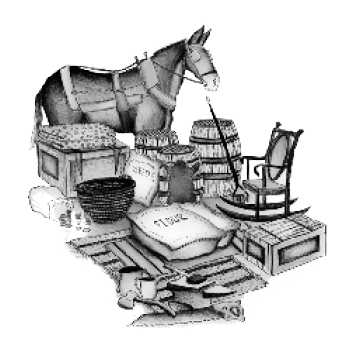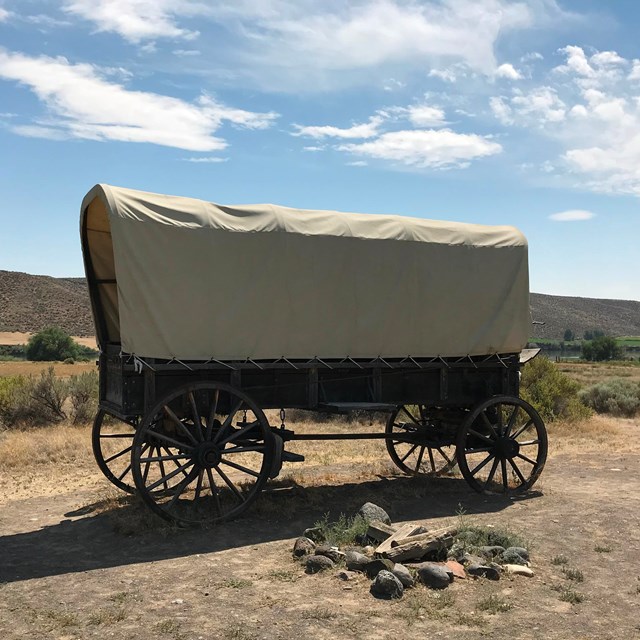Last updated: February 12, 2024
Article
Oregon Trail Junior Ranger
Interested in becoming a junior ranger?
Use the information below to complete your worksheet!
Once you are done, follow the steps on how to Become a Junior Ranger to submit your worksheet.
Oregon! The very word evoked visions of paradise. Towering trees. Lush valleys with rich soil. Land of unlimited opportunity. Between 1840 and 1869 those visions lured over 500,000 pioneers west to fulfill their dreams and a nation’s destiny. Their 2,000-mile route is known today as the Oregon Trail.
Beginning, the Gateway West
Long before it was a wagon road, the Oregon Trail was part of an ancient network of Indian footpaths and animal trails that crisscrossed the West. In the early 1800s British, French, and American fur trappers followed those paths as they hunted for beaver, whose fur was in demand for stylish hats in Europe. In 1812 fur trader Robert Stuart and six companions, following an Indian trace in today’s Wyoming, made an important discovery—a wide pass, 7,550 feet in elevation, across the Continental Divide. South Pass made overland travel with ox-drawn wagons possible, and it became the gateway to the West. In 1851 Amelia Hadley wrote: “There we saw the far famed south pass, but did not see it until we had passed it for all the time I was looking for some narrow place . . . but was disappointed.”
Freight wagons began to beat a track along the Platte River and South Pass in the 1820s and 1830s. These fur brigades carried supplies from St. Louis to the fur trappers’ annual Rendezvous in the Green River country of today’s Wyoming and Utah. Returning caravans hauled pressed beaver pelts to Missouri. This “fur trace,” wheel tracks along the Platte and through the Rockies, began the Oregon Trail. Christian missionaries eager to convert Indians took advantage of the fur traffic between East and West, joining caravans for safe passage. Missionaries Marcus and Narcissa Whitman and Henry and Eliza Spalding joined the 1836 fur brigade to Wyoming, then headed to Oregon Country. Narcissa and Eliza were the first white women to cross the continent on what became the Oregon Trail.
As the 1830s ended, so did the supply of beaver. The last mule cart and missionary brigade headed up the trace toward the final Rendezvous in April 1840—accompanied by Joel Walker, his family, and two wagons. From the Rendezvous, the Walkers joined trappers and headed to Fort Hall, a trading post on the Snake River in today’s Idaho. They sold their wagons and continued west with a fur company pack train bound for Fort Vancouver. Joel and Mary Walker and their four children arrived in Oregon’s Willamette Valley in mid-September—and Mary gave birth to a baby four months later. They proved that families could make the overland trip, opening the Oregon Trail for other pioneer families.
Why Go West?
Economic depressions in 1837 and 1841 left desperate farmers and businessmen looking for new opportunities. Politicians urged people to go West, where a stronger American presence might help wrest the disputed Pacific Northwest from British control. Missionaries described the land’s fertility and promoted its development potential. A growing spirit of national pride and the idea of Manifest Destiny—that God intended the United States to stretch from coast to coast—made it seem a citizen’s patriotic duty to go West. The fur trade had crashed, leaving unemployed trappers looking for new work as trail guides.
In early 1841 the first emigrant wagon train set out from Independence, Mo. The party of about 80 men, women, and children joined guide Thomas Fitzpatrick. He led them up the Little Blue River across northeastern Kansas, following the old fur trace along the Platte River. The wagons rumbled by Chimney Rock’s spire and Scotts Bluff’s prominence. On the Sweetwater River they passed by Independence Rock and the cleft called Devil’s Gate, finally starting up a long, wide, gentle grade—South Pass! The emigrants were on the Pacific side before they realized they had crossed the Continental Divide.
The travelers separated at Soda Springs. The core, the Bidwell-Bartleson Party, headed to California, while the others followed Fitzpatrick to Fort Hall. The Oregonbound travelers hired a new guide to pilot them along the Snake River and over the Blue Mountains, and Indians guided them down the Columbia River to Willamette Valley. This route became the Oregon Trail corridor.
By 1845 Americans outnumbered the British, and in 1846 Britain surrendered its territorial claim and withdrew to Canada. In 1850 Congress passed the Donation Land Act, offering 160 acres of free Oregon land to white males or half-Indian settlers and another 160 acres to their wives. Travel (and weddings) boomed as settlers rushed to stake claims before the law expired in 1854. At first Indians helped emigrants, but things changed as they discovered that the “free territory. By the mid- to late 1800s settlers land” offered to whites was their ancestral lay claim to most tribal lands.
From Path to Highway
For emigrants the lure of land and opportunity outweighed personal sacrifices and the risks of long-distance wagon travel. It meant backbreaking toil and the possibility of death from accident, violence, or disease. Even so, traffic on the trail kept growing. Just 10 years after the Walkers followed the old fur trace, a well-beaten road sprawled across the prairie. Traffic was not just westbound. Discouraged pioneers turned around; successful settlers returned to persuade family and friends to join them in Oregon; and supply wagons rumbled to and from military forts.
This highway was not straight, smooth, or direct. It followed streams, wound around hills, and avoided deep sand. On steep slopes travelers lugged wagons up with ropes and stuck poles in wheel spokes to brake them on the way down. At dangerous river crossings, they floated wagons on makeshift ferries. Worst was The Dalles—a fearsome stretch of Columbia River rapids—where many pioneers floating on rafts perished close to their final destination. In 1846 the Barlow Toll Road provided a safer route, one of many cutoffs developed between jumping-off places in Missouri and trail’s end at Oregon City, Ore.
Indians and Emigrants
In the first decade of Oregon Trail travel, relationships between Indians and emigrants were generally cooperative. Tribes provided fresh meat, guided travelers across rivers, and helped search for lost livestock. Most emigrants returned these favors with kindness. But tensions grew when the stream of wagons increased in 1849 in response to the California gold strikes. Livestock trampled native plants, and emigrants slaughtered buffalo herds that tribes needed for sustenance. Some Indians tried to collect payment for passage across tribal lands, but most emigrants regarded these requests as arrogant demands for tribute.
Relations deteriorated by the late 1850s. Indians killed travelers and emigrants killed Indians. In the Oregon Territory farming, mining, and logging destroyed salmon runs and village sites. Indian resistance all along the trail persisted into the 1880s. By then the Indians had suffered military defeats, settlers had claimed their most productive lands, treaties were made and broken, and most tribes were forced onto reservations. In just a few decades the American landscape was changed forever.
An Enduring Legacy
This remarkable story began drawing to a close in 1869 with completion of the transcontinental railroad. People still used parts of the old wagon road for local trips, and the better stretches of Trail became paved roads and highways. Over the years other traces of the Oregon Trail were plowed under, built over, or faded away. In 1906, 76-year-old Ezra Meeker, who crossed the plains to Oregon in 1852, set out in a covered wagon to retrace the old Trail from west to east. He meant to mark the route before it was gone, publicize the Trail’s history, and encourage protection of the wagon ruts that remained. Meeker met with two U.S. presidents, testified before Congress, and made several publicity trips along the route before his death in 1928.
In 1978 Congress authorized the old wagon road as the Oregon National Historic Trail, recognizing its importance in American hisstory. Today the Trail is administered by the National Park Service and managed by the Bureau of Land Management, U.S. Forest Service, other federal agencies, state and local governments, and private landowners. They work together to protect the Trail’s legacy, provide public access, and tell its stories.
Trail Timeline
Before 1700
Indians live throughout the country centuries before Europeans arrive. Although of different tribes and languages, they establish extensive trading networks.
1750-1800
Plains Indians obtain horses and guns. The horses provide mobility; guns enable better hunting and defense. White explorers and fur traders follow Indian trails west.
1800-1830
Louisiana Purchase doubles U.S. territory. Meriwether Lewis and William Clark expedition opens American West. Monroe Doctrine initiated, keeps European powers from meddling in U.S. affairs.
1836-1837
Missionaries Marcus and Narcissa Whitman attend the Rendezvous in Wyoming, then travel to Oregon territory; banks fail; economic depression sweeps United States; eastern citizens consider a new life in the West.
"Dearest mother, For two or three days past I have felt weak, restless and scarcely able to sit on my horse. But see how I have been diverted by the scenery, and carried out of myself in conversation about home and friends. . . . [recalling] my last impressions of home . . . I forget that I am weary and want rest."
—Narcissa Whitman, August 29, 1836 1
1843
Nearly 1,000 emigrants complete the trip to Oregon. American settlers there organize a provisional government for self-rule, separate from British or U.S. control.
1845-1848
U.S. thirst for expansion and economic opportunity spurs thousands to hit the trail; gold found in California.
"Out in Oregon I can get me a square mile of land . . . Dad burn me, I am done with this country, Winters it’s frost and snow . . . summers the overflow from Old Muddy drowns half my acres; taxes take the yield of them that’s left."
—Peter Burnett, emigrant, 1843
"Our manifest destiny [is] to overspread the continent allotted by Providence for the free development of our yearly multiplying millions."
—John L. Sullivan, editor, 1845 Lansford Hastings Guidebook
"This country was once covered with buffalo . . . Since the white man has made a road across our land, and has killed off our game, we are hungry . . . Our women and children cry for food and we have no food give them."
—Chief Washakie, Eastern Shoshone, 1855
1849-1850
Cholera kills thousands of overlanders; Donation Land Act of 1850 promotes homesteading in Oregon and allows a married woman to hold land in her own name.
1851-1861
About one-third who cross the plains are women, 1852; Oregon gains statehood 1859; Pony Express comapny delivers fast, up-todate news, unites East and West coasts.
1862-1869
Indians rise up as white settlement leads to loss of traditional homeland and broken treaties; transcontinental railroad completed, signals end of covered wagon travel.



